Why India is called (named) as Bhārat (ancient) | What are the 7 islands in Hinduism | Who named India as Bhārat | Who is real Bharat of India
Namaste friends, how are you doing today? Welcome to #BhagavanBhakthi website / blog.
Bhagavan Lord Sri Krishna (Lakshmi Narasimha) (Vitthal) (Vishnu) (Rama) (Trivikrama) and Goddess Sri Rukmini (Lakshmi) blessings to you and your family!
In this website / blog, you will always learn about #Hinduism #Sanskrit language.
Also subscribe to my YouTube channel from this link #BhagavanBhakthi to view videos about #Hinduism #Sanskrit language.
Just before going to “Why India is called (named) as Bhārat (ancient) | What are the 7 islands in Hinduism | Who named India as Bhārat | Who is real Bharat of India“, let us know a brief, basic and very important information.
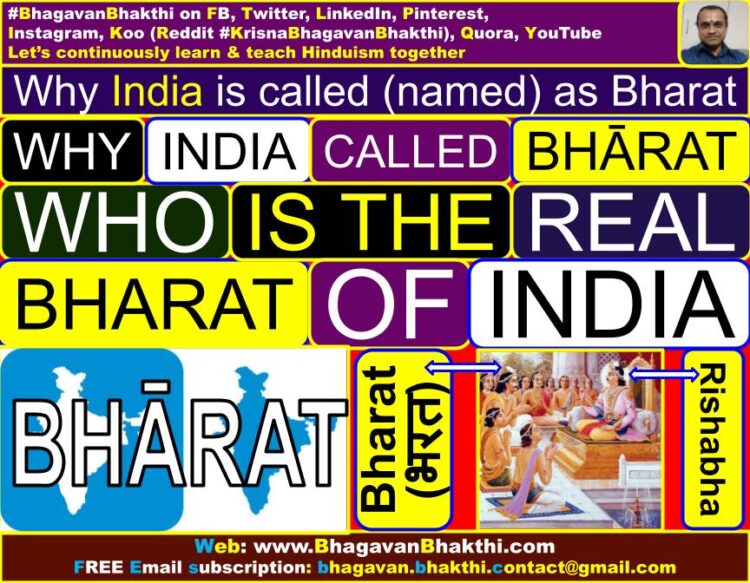
In India’s national anthem it is clearly stated that “Bharata bhagya vidhata” – This means there is someone who glorifies the greatness of the country called ‘भारत’ (Bhārat) (Bhārata). The person Bharat (Bharata) got his glory from his Vidhata.
Here Vidhata means Lord Sri Vishnu in the avatar of Lord Rishabha (Rishabhanatha). Lord Rishabha’s (Rishabhanatha) son name is Bharata (Bharat) (भरत).
Since from Lord Rishabha (An avatar of Lord Vishnu) his son Bharat (Bharata) got his glories, and thus our country got the name ‘भारत’ (Bhārat) (Bhārata).
Some people have given explanation that a King named Bharat (Bharata) Chakravarti (Emperor) who comes in the lineage is Arjuna and Pandavas is the real person on whom our country got the name Bhārata (Bhārat).
But, this explanation doesn’t give satisfactory authorization that this King named Bharata (Bharat) is the real person from whom India got the name. ‘भारत’ (Bhārat) (Bhārata) Because this name doesn’t satisfy the explanation of our India’s national anthem with the words “Bharata bhagya vidhata”.
Below given explanation is taken from Varaha Purana, in which the svayam Bhagavan Lord Sri Varaha Swamy (an avatar of Bhagavan Lord Sri Vishnu) explains to his beloved wife Prithvi or Bhoodevi (Mother Earth) about the real Bharata (Bharat) (भरत) and how India got the name ‘भारत’ (Bhārat) (Bhārata).
While explaining, Bhagavan Lord Sri Varaha tells to Prithvi or Bhudevi (Mother Earth) that once Lord Shiva explained about the Bhuloka (upper layer of the Earth), mountains and islands to few of the Rishis / Sages.
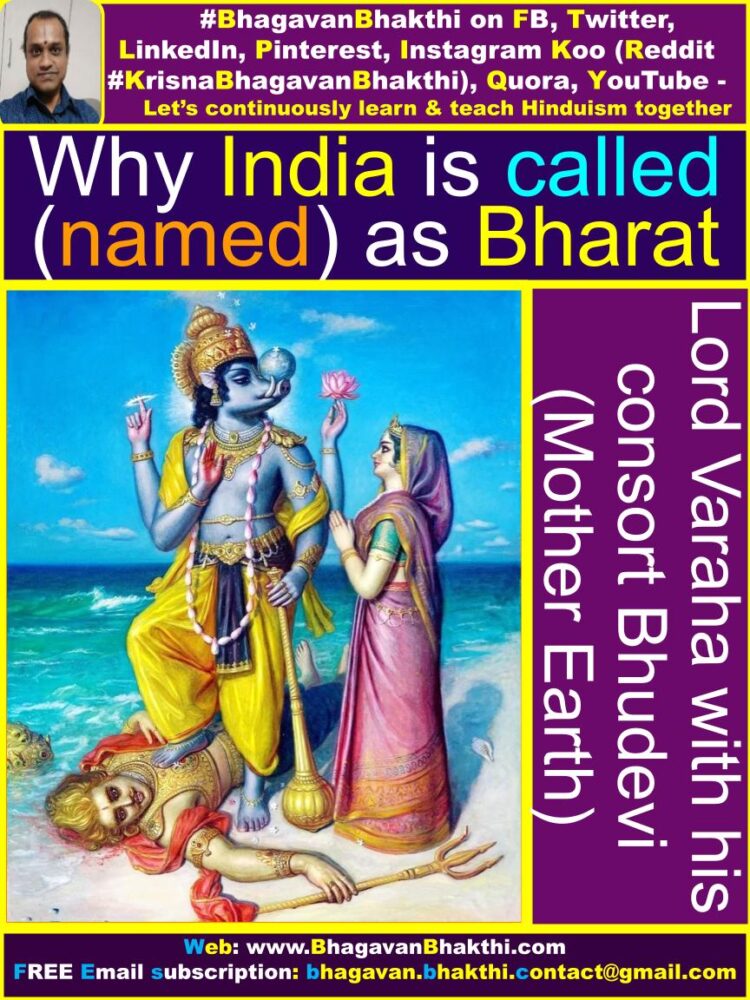
The Rishis / Sages started to listen with rapt attention to the description of Lord Shiva made of the Almighty Bhagavan and Supreme Lord Sri Narayana (Vishnu).
But, Rishis / Sages had few queries in store, so they asked Lord Shiva: “O Lord of Uma Devi (husband of Goddess Uma Devi / Parvati Devi)! please tell us about the expanse of the Earth, the situation of mountains and the prominent islands.”
Thus Lord Shiva replied: “Bhuloka is situated on the surface of the Earth, while the earth itself is based on Almighty’s (Bhagavan Lord Sri Vishnu) chest. With the desire of creating the three basic gunas, that is, Satvika, Rajasika and Tamasika, the Almighty Bhagavan Lord Sri Narayana (Vishnu) created water first of all and went into ‘yoganidra’.”
Lord Shiva continued: “Then a lotus flower manifested from HIS (Narayana / Vishnu) navel on which was seated was Lord Sri Brahma Deva. Lord Sri Brahma then created his manasputras (sons born from the mind), that is, Sanaka, Sanandana, Sanatana and Sanatakumara all of whom were enlightened souls.”
Lord Shiva continued: “Then Lord Sri Brahma Deva created Rishis / Sages like Daksha etc. Daksha’s daughter Shatarupa was married to Manu from whom she had two sons, that is, Priyavrata and Uttanapada.”

Lord Shiva continued: “Uttanapada had ten sons, that is, Aaghnighna, Agnibahu, Medha, Medhatithi, Dhruva, Jyotishmana, Dyutimana, Havya, Vayushmana and Savana. He had divided the earth into seven islands and presented them to each of his seven sons.”
(Note : Please remember that even today on earth we have seven islands / continents on our earth. That’s why Hindu Sanatana Dharma is so accurate and perfect since unknown time.)
1. Aaghnighna became the king of Jambu Dvipa. | 2. Medhatithi became the king of Shaka Dvipa. | 3. Jyotishmana became the king Krauncha Dvipa. | 4. Dyutimana became the king of Shalmali Dvipa. |
5. Havya became the king of Kusha Dvipa. | 6. Vayushmana became the king of Plaksha Dvipa and | 7. Savana became the king of Pushkara Dvipa.
8. Dhruva became the celestial star and | 9. Agnibanu was given a separate power. |
Savana had two sons, that is, Dhata and Mahaveeti, who were the rulers of ‘Dhatki’ and ‘Kaumuda provinces respectively. Similarly Dyutimana had three sons, that is, Kusha, Vaidyuta and Jeemutvahana.
Jyotishmana had seven sons, that is, Kushala, Manugavya, Peevara, Andhra, Andhakaraka, Muni and Dundubhi. Kusha had seven sons, that is, Udbhida, Venumana, Rathapal, Manu, Dhriti, Prabhakara and Papila.
Medhatithi too had seven sons, that is, Nabhi, Shantmaya, Shishira, Mukhodama, Nandashiva, Kshemaka and Dhruva. Nabhi’s wife was Merudevi, who had given birth to Rishabha.
Lord Rishabha (He is an avatar of Bhagavan Lord Sri Vishnu) and he is the father of Bharata (Bharat) upon whom the area lying south of Himalaya mountain is named Bhārat (the present Bhārat / India).
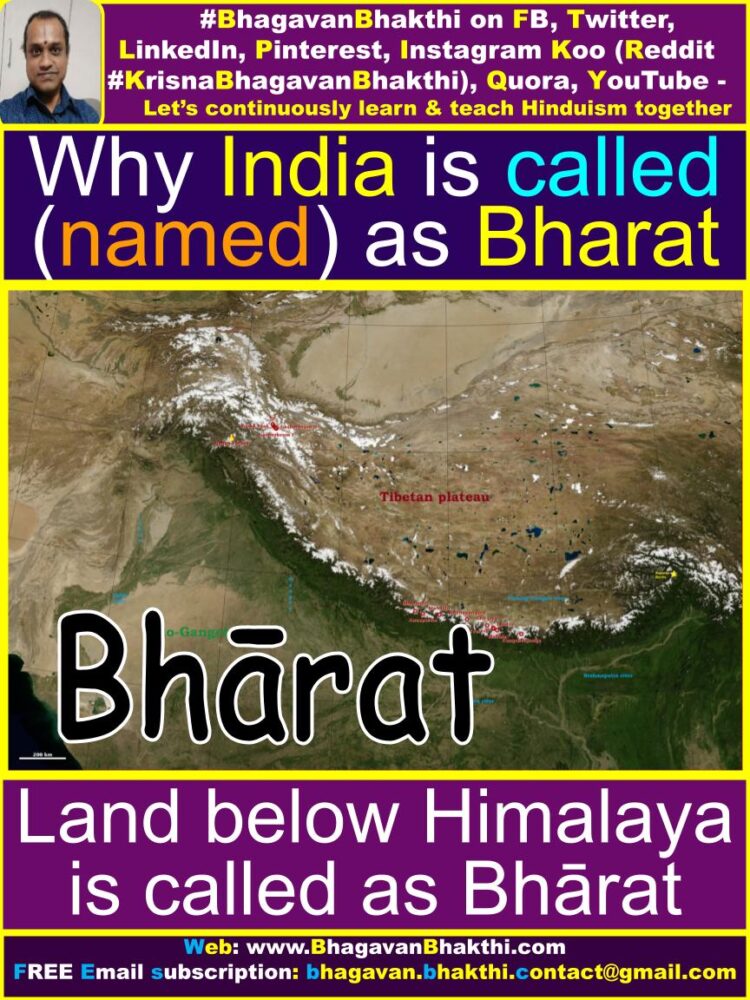
Sumati was the son of Bharata (Bharat). Bharata (Bharat), after appointing Sumati as his successor went into the forest to do penance.
The names of some prominent kings coming from the lineage of Sumati were Teja, Satsuta, Indradyumna, Parmeshthi, Pratiharta, Nikhata, Unmeta, Abhava-Udgata, Prastota, Vibhu, Prithu, Ananta, Gaya, Naya, Virata, Mahavirya and Sudhimana.
Sudhimana had one hundred sons. This way the population continued to grow. The four yugas, that is, Satya (Krita) Yuga, Treta Yuga, Dvapara Yuga and Kali Yuga occur in a cyclic order.
Each of the latter follows the former. A Manvantara comprises of 71 Chaturyugas (four yugas – Satya / Krita Yuga, Treta Yuga, Dvapara Yuga and Kali yuga) or together all these Yugas are known as ‘Mahayuga’.
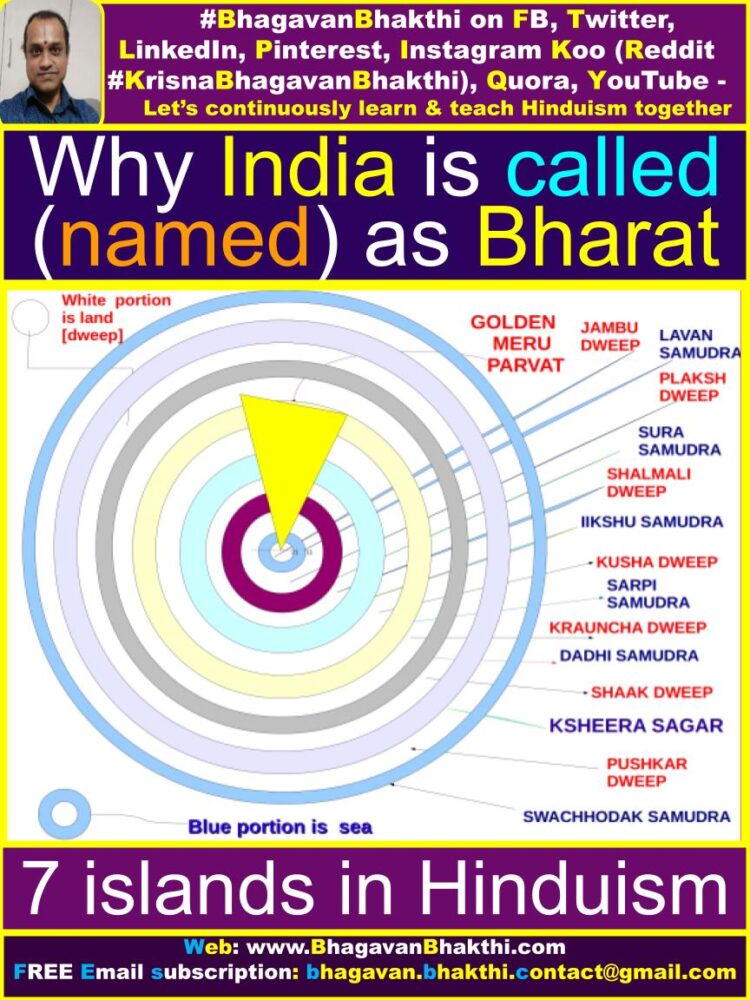
The different types of islands (dvipas) or continents as per Hinduism (cosmology) is as given below:
JAMBUDVIPA – Jambudveepa is spread in the area of one lakh yojana and it consists of numerous Janapadads. It is inhabited by ‘siddhas’ and ‘charanas’ and is blessed with incomparable natural beauty.
A total number of nine ‘Varshas’ lie within the territory of Jambudveepa which itself is surrounded by various oceans on all sides. Towards its east and west lie salt water oceans. Some prominent mountains of Jambudveepa are the Himalaya, the Sumeru, the Hemakuta and the Nishadha.
Territory situated towards east of Sumeru mountain is inhabited by the fair complexioned Brahmins (Brahmanas). Towards its south live Vaishyas. Shudras live towards the south of Sumeru and the area lying towards its north is inhabited by Kshatriyas.
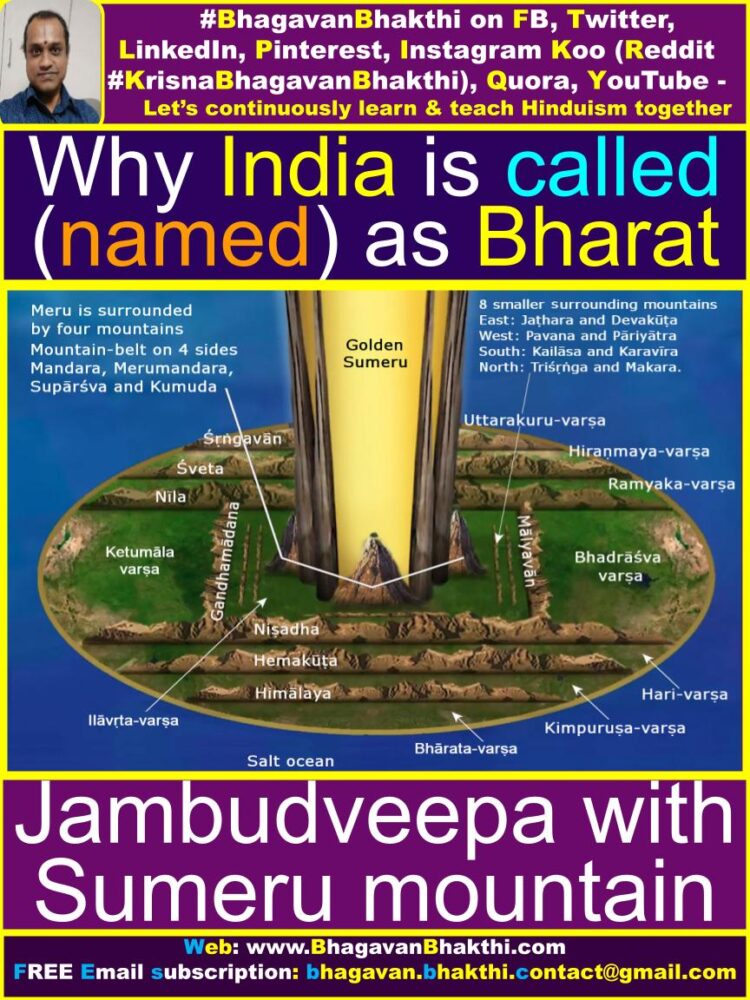
Continent or island Jambudvipa (Rose Tree Island) also known as Sudarsanadvipa forms an inner concentric island in the above plan. It is believed that the island was named after the people who lived on the island known as Sambavas.
Jambu Dvipa name is said to be derived from the Jumbo tree (another name for the Indian blackberry). The fruits of the Jambu tree are said in the Vishnu Purana (Chapter 2) to be as big as elephants and when they rot and fall on the tops of mountains, a river of juice is formed from their expressed juice.
The river thus formed is called Jambunadi (Jambu River) and flows through Jambudvipa, whose inhabitants drink its water. The continent of Jambudvipa is said to consist of nine varshas (zones) and eight significant mountains (parvatas).
The Markandeya Purana depicts Jambudvipa as depressed in its south and north and high and broad in the middle. The highlands form the varsha named Ila-vrita or Meruvarsha. In the center of the Ila-vrita is the golden mountain of Meru, the king of mountains.
On the peak of Mount Meru is the vast city of Lord Sri Brahma known as Brahmapuri or Brahma Loka or Satya Loka. There are 8 cities around Brahmapuri – one of Indra and the other seven deities (Devatas) (Demigods).
The Markandeya Purana and the Brahmanda Purana divide Jambudvipa into four broad regions in the shape of the four petals of a lotus (kamala), with Mount Meru in the center as a pericarp. The city of Brahmapuri (Brahma Loka or Satya Loka) is said to be surrounded by a river known as Akasha Ganga.
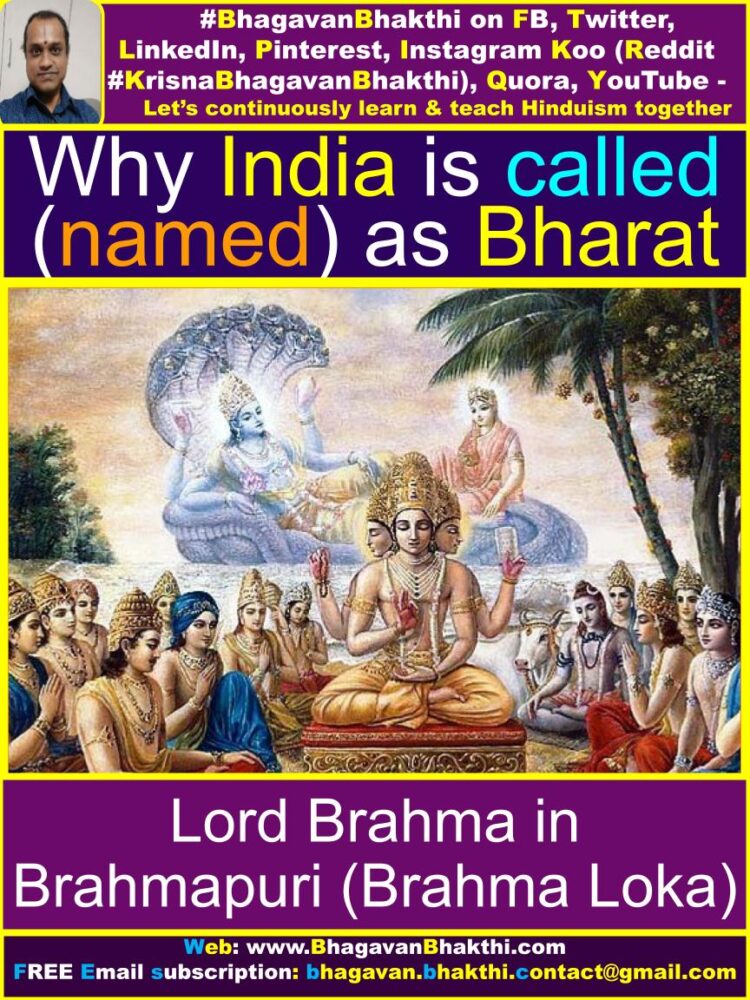
The Celestial Ganges or Akasha Ganga is said to emerge from Lord Vishnu’s lotus feet and fall “through the sky” after washing the lunar region and “split into four mighty streams” after encircling Brahmapuri, which are said to flow through the landscape in four opposite directions and irrigate the vast lands of Mount Meru and Jambudvipa.
The common names of the islands, their varshas (9 for Jambu-dwipa, 7 for other islands) are given in several Puranas along with a mountain and a river for each year. However, other Puranas provide a different set of names. The most detailed geography is described in the Vayu Purana.
SHAKA DVIPA – It’s area is approximately twice as compared to Jambudweepa. It is inhabited by virtuous people who are prosperous and who enjoy a long life. They are free from the tortures of old age.
This island is covered by oceans on its two sides, that is, salt water ocean on one side and ‘Ksheera Sagara’ (Ocean of Milk) on the other. The mountain ranges lying in the northern part of this island is known as Udayachala while ‘Chandragiri is situated in the western part.
There are some other mountain ranges like Rajatagiri, Aambikeya, etc. situated on this island. Altogether these mountain ranges total seven in number and are known as ‘Kula-Parvatas’.
Some prominent rivers flowing through this island are Sukumari, Kumari, Nanda, Venika, Dhenu, Ikshumati and Gabhasti. There is a large tree named Shaka in the central part of this island. This is how this island derived it’s name.

Shakadweepa (Teak Island), is an island that features in Hindu Puranas. The island or continent is named after a large teak tree said to be worshiped in its centre. Its territory and inhabitants are described in Puranas.
Brahma Purana – According to the Brahma Purana, the ocean known as Ksheera Sagara is surrounded by Shakadvipa, which is described as twice the size of another island, Kraunchadvipa. The sovereign of the island is called Bhavya, and is mentioned as having seven sons, giving each a tract of land: Jalada, Sukumara, Kaumara, Manichaka, Kusumottara, Modaka and Mahadruma.
The seven mountains in this island are Udaya, Jaladhara, Raivataka, Shyama, Ambikeya, Astikeya and Kesari. A large Shaka (teak) tree is described as growing there frequently by the Gandharvas and Siddhas.
Members of the four varnas living here do so without contracting any disease. Magas are Brahmins, Magadhas are Kshatriyas, Manasas are Vaishyas and Mandagas are Shudras.
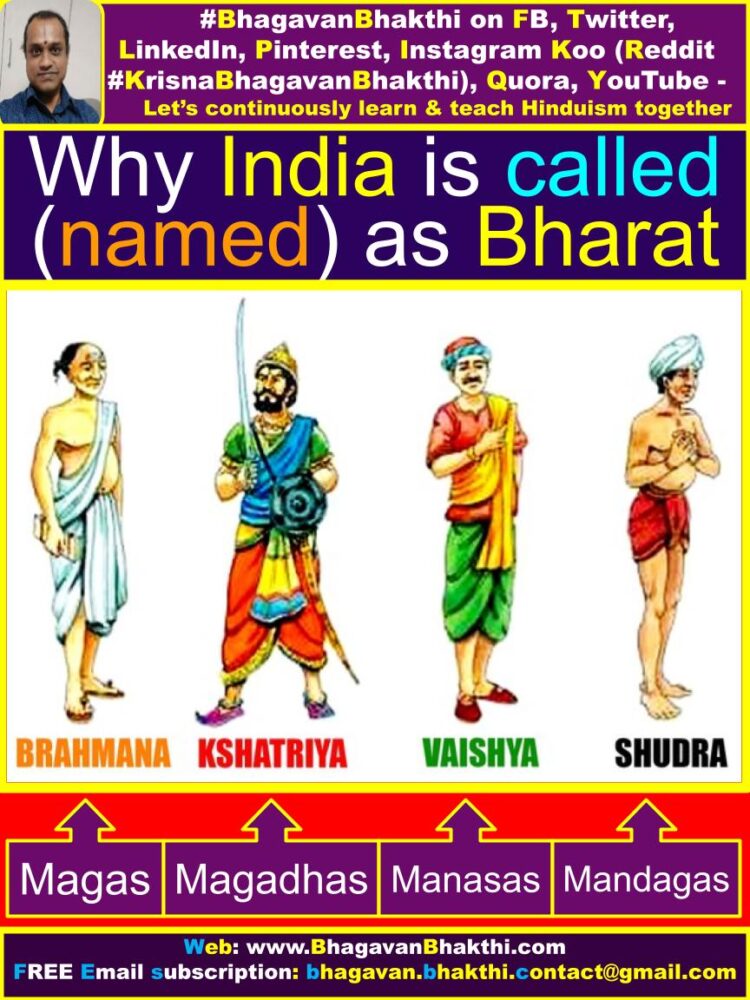
Vishnu Purana – The narrative of Shakadvipa in Vishnu Purana is similar to that of Brahma Purana. The inhabitants of this island are described as extremely virtuous, feeling no jealousy and transgressing no boundaries.
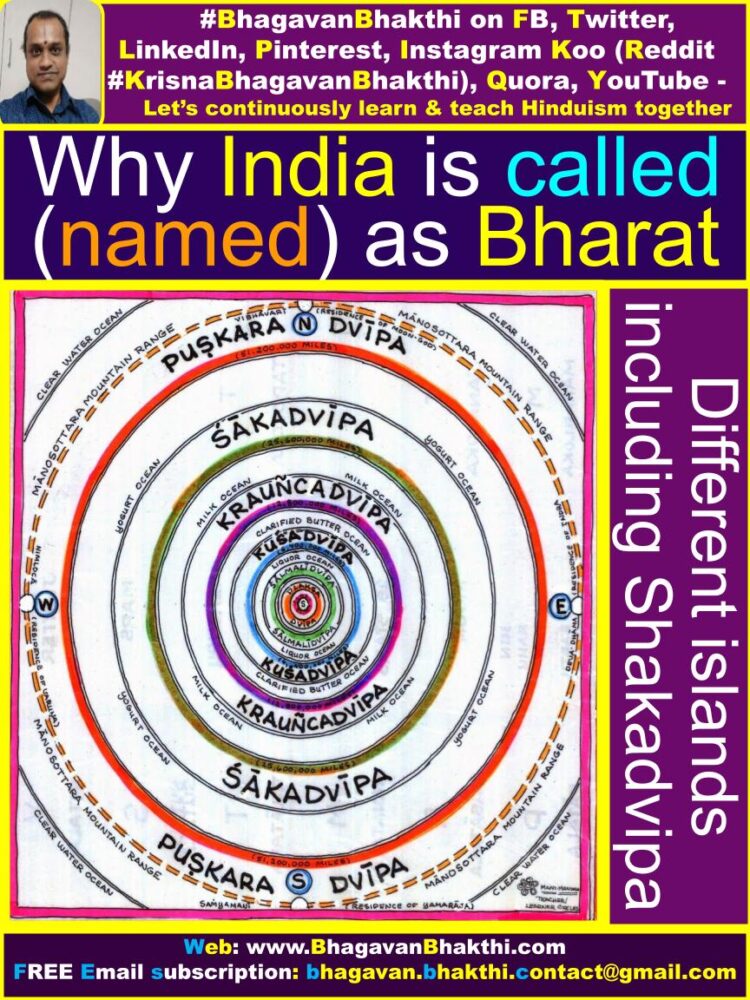
KUSHA DVIPA – This island or continent is twice the area of Shaka dveepa. There are seven prominent mountain ranges in this island which are known as ‘Kula Parvatas’, that is, Kumuda, Unnata, Drona, Kanka, Isha, Mahisha and Mandara.
There are seven prominent rivers flowing through the various parts of this island, that is, Pratoya, Shiva, Chitra, Chandra, Vidyullta, Varna and Mahati. This island has got its name from Kusha grass which are found in abundance in its central part. According to Varahapurana chapter 87 Kushadweepa is one of the seven islands (Dweepa).
In chapter 74 this island is identified as Plakshadweepa, ruled by Vapushman, one of the ten sons of Priyavrata, the grandson of Swayambhuva Manu. Swayambhuva Manu was created by Lord Brahma, who was in turn created by the the Surpeme Sri Narayana (Vishnu).
These are the seven major rivers found in Kuśadvīpa namely – Pratoyā (or, Praveśā), Śivā (or, Yaśodā), Citrā (or, Kṛṣṇā), Hrādinī (or, Candrā), Vidyullatā (or, Śuklā), Varṇā (or, Vibhāvarī), and Mahatī (or, Dhṛti).
The Varāhapurāṇa is categorised as a Mahāpurāṇa, and was originally composed of 24,000 metrical verses, possibly originating from before the 10th century. It is composed of two parts and Sūta is the main narrator.
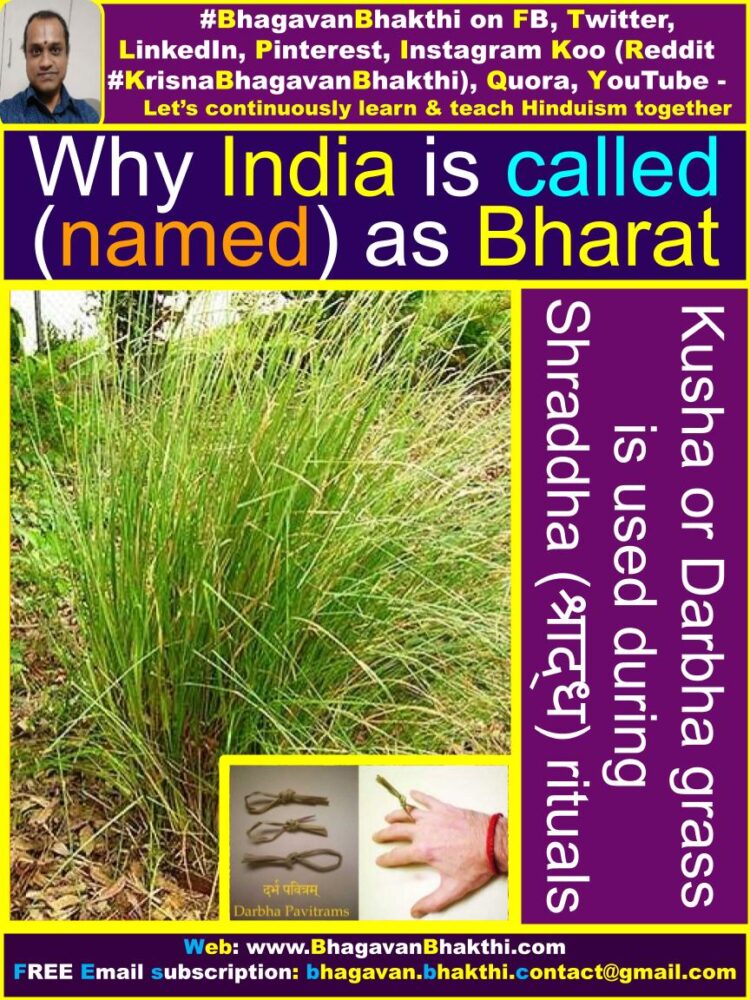
KRAUNCHA DVIPA – It is twice the area of Kusha Dveepa. It has seven prominent mountain ranges, that is, Krauncha, Paavana, Devavrita, Devishtha, Devaananda, Govinda and Pundareeka.
There are also six prominent rivers flowing in this island, that is, Gauri, Kumudavati, Ratri, Manojava, Khyati and Pundarika. Krauncha Dveepa is surrounded by an ocean of clarified butter (ghee) on all its side.
The inhabitants of Kraunchadwipa worship with this mantra. “O water of the rivers, you are empowered by the Supreme Personality of Godhead Lord Sri Krishna. So you purify the three planetary systems known as Bhuloka, Bhuvarloka and Svarloka. By your constitutional nature, you remove sins and that is why we are touching you. Please continue to purify us.”
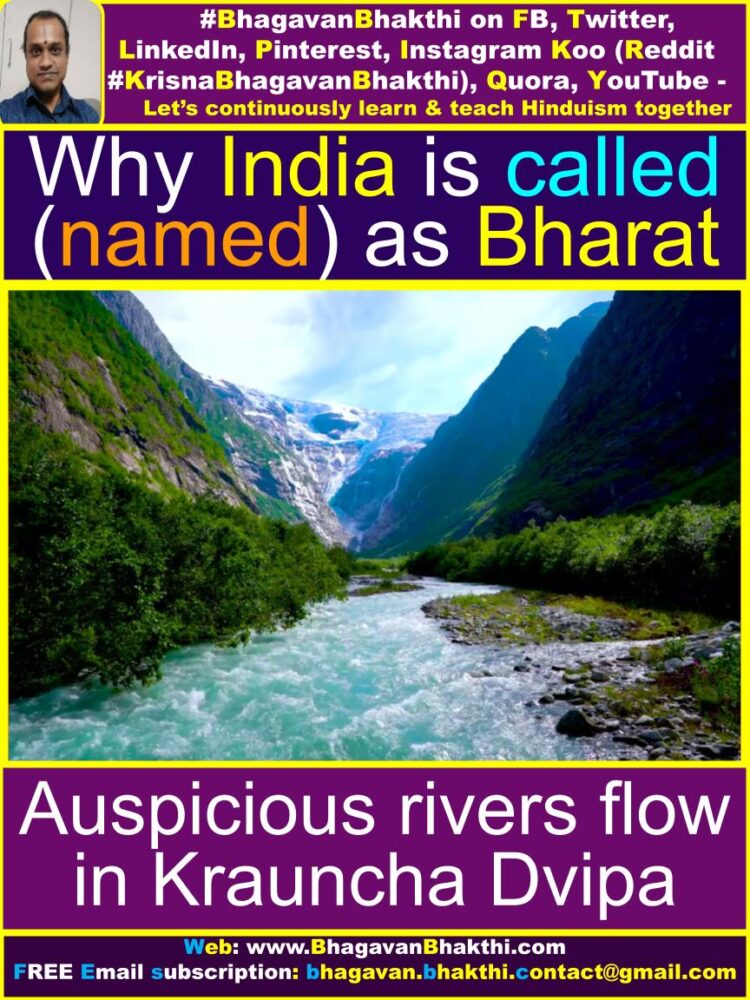
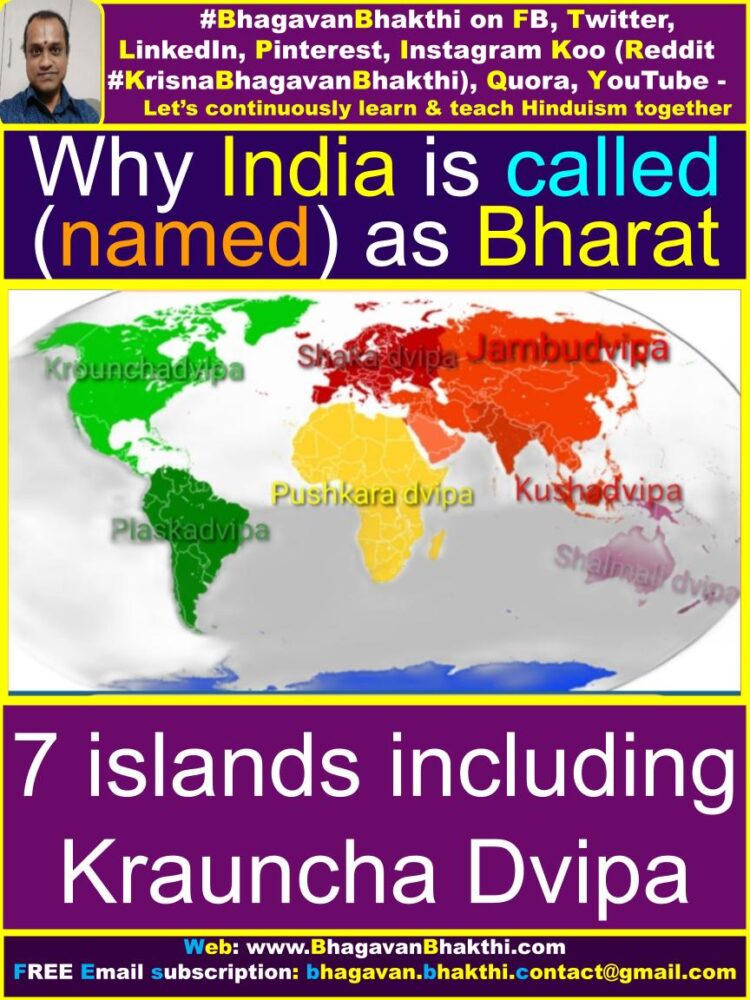
SHALAMALI DVIPA – It is double the area of Krauncha Dveepa and covers the ‘clarified-butter’ ocean from all sides. There are seven prominent mountains as well as seven rivers in this island.
Shalmalidwipa (शालमालिद्वीप) is one of the seven islands, ruled by Dyutiman, one of the ten sons of Priyavrata, according to the 74th chapter of the Varahapurana. Priyavrata was the son of Swayambhuva Manu, who was created by Lord Brahma, who was created by Lord Narayana (Vishnu).
These are the seven major mountains of Shamalidweep: Sarvaguna, Sauvarna, Rohita, Sumanasa, Kushala, Jambunada and Vaidyuta.
The Varāhapurāṇa is categorised as a Mahāpurāṇa, and was originally composed of 24,000 metrical verses, possibly originating from before the 10th century. It is composed of two parts and Sūta is the main narrator.
There are seven mountains that produce gems and they are seven boundaries that separate the regions. Also there are seven rivers. The seven rivers are Yoni, Toya, Vithruna, Chandra, Mukta, Vimochani and Nirvriti.
Just the remembrance of the seven rivers is enough to destroy all sins. People divided into four classes live here. Here Brahmins, Kshatriyas, Vaishyas and Shudras are called as Kapilas, Arunas, Peetas and Krishnas. These devout people worship Lord Sri Vishnu in the form of Vayu through grand yajnas.
Devatas (Demigods) are always present in this most beautiful island. Salmali, a tree that gives mental peace, grows on this island. The island is surrounded on all four sides by the ocean of Sura (liquor). (Vishnu Purana, Part II, Chapter 4).
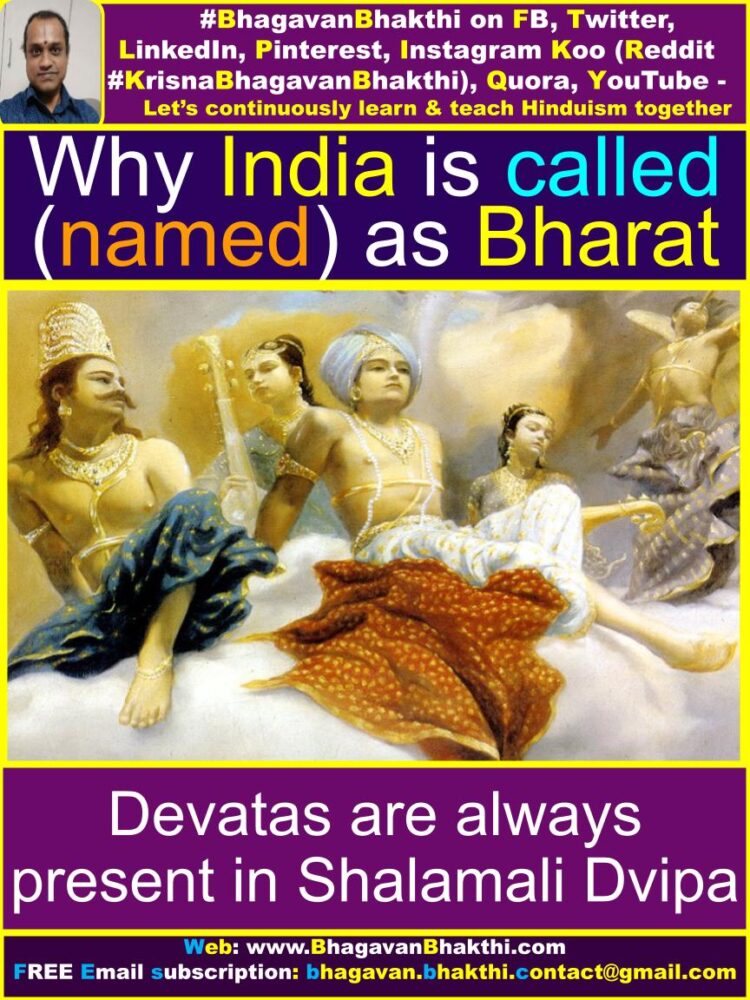
Plaksha Dvipa – Plakshadweep (प्लक्षद्वीप) is one of the seven islands or continents envisioned in Hindu cosmology. The word Plakshadweepa literally means “Land of Fig Trees”, where Plaksha is the Sanskrit name for the fig tree and dvipa means “island” or “continent”.
In the Brahma Purana, Plakshadweep is described as a Heaven of 100,000 yojanas wide, with seven main mountains and seven main rivers. The latter reference has the ability to “completely remove sins” and “the people of the region will drink its waters and be happy”.
In the center of the continent is a huge fig tree, which gives the region its name. Its ruler, Medhatithi, had seven sons, Shantabhaya, Shisira, Sukhodaya, Ananda, Shiva, Kshemaka and Dhruva, who ruled sub-kingdoms in the continents.
Its inhabitants are described as living for minimum 5,000 years, living a life of perfect health and happiness according to their dharma. Worshiping Lord Sri Krishna in the form of Soma is the primary dharma of this island.
The four varnas of people living in Plakshadweep – Hansas, Patangas, Urdhvayanas and Satyangas – purify themselves taking bath in the rivers of the island. The inhabitants of Plakshadweep live for a thousand years. They are beautiful like Devatas (Demigods) and they also bear children like Devatas (Demigods). The rivers names are Runa, Nrimna, Angirasi, Savitri, Suptabhata, Stambhara and Satyambara.
By fully performing the rites mentioned in the Vedas and worshiping the Supreme Personality of Godhead Lord Sri Vishnu, represented by the Sun-god, they attain the heavenly planet Surya.
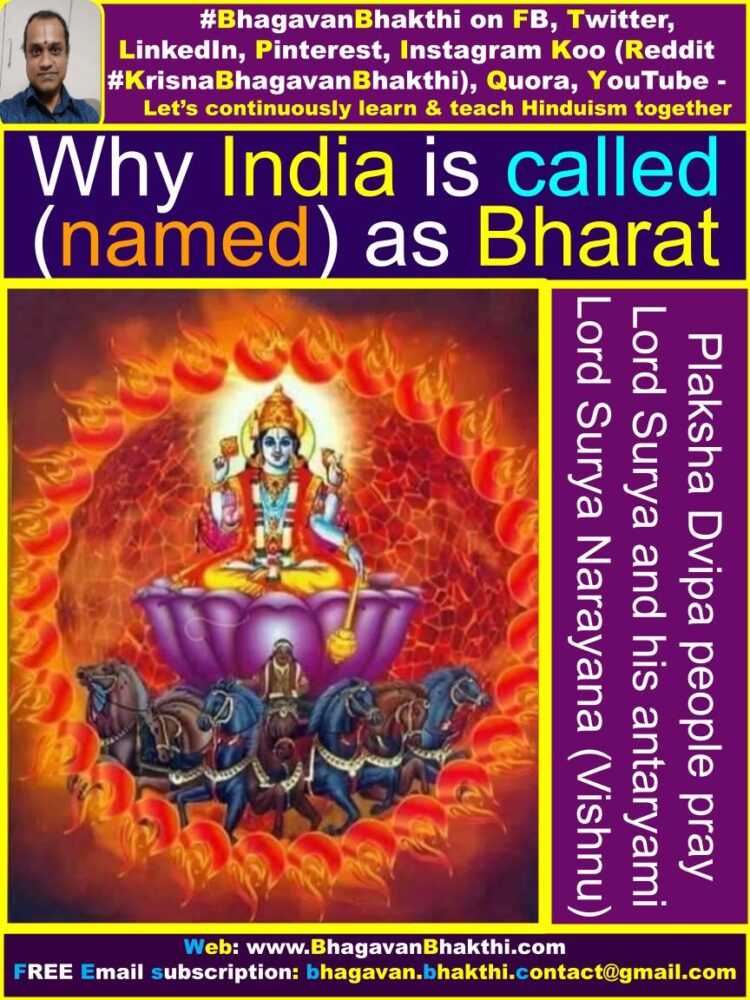
Pushkara Dvipa – Pushkaradweep (पुषकराद्वीप) is one of the seven islands (dvipa) ruled by Savana, one of the ten sons of Priyavrata, according to chapter 74 of the Varaha Purana. Priyavrata was the son of Swayambhuva Manu, who was created by Lord Brahma, who was created by Lord Narayana (Vishnu).
The island is twice the size of Dadhimando, and is surrounded by a sea of fresh water: named after a huge lotus with a golden petal, intended to contain the throne of Brahma, called after King Pushpavahana of Rathantakalpa. Here there is a Citrasanu hill.
In the middle of this island there is only one mountain, Manasottara, which is divided into eastern and western parts. Above it are the cities of gods like Lord Indra in the four directions. At its top is the chariot wheel of the sun, making the year of men and the day of the Devatas (Demigods).
Vitihotra, son of Priyavrata, was the ruler who divided this island between his two sons. Lord Brahma is worshiped here. People live here for 10,000 years. There is no caste or Vedas on this island. They worship the banyan tree.
Maharishi Kashyapa displayed his Ashwamedha Yajna and Vali defeated Ravana here. Parashurama had visited this place. One of the seven continents of which Savana was the first king. His sons Mahavira and Dhatuki divided it between them.

More information will be added to his post (article) on regular basis. Please visit again to know the updated information after some time.
Let’s know more info about Hinduism (Sanatana Dharma) and Bhagavan Lord Sri Krishna (Vishnu) by clicking the below link:
Hinduism (Sanatana Dharma) information, facts, etc.
Lord Sri Vishnu stories, information, facts, significances, etc.
Continue reading about Hinduism (Sanatana Dharma) :
Rivers information in Hinduism (Sanatana Dharma)
Mahabharata information, facts, significance, importance etc.
Ramayana information, facts, significance, importance, etc.
To watch, “When was Hinduism (Sanatana Dharma) was started“, please click the below YouTube video link:
To watch videos on #Hinduism #Sanskrit language, SUBSCRIBE to my YouTube channel from this below link:
#BhagavanBhakthi YouTube channel
Dear friends, if you need any clarifications about this post, kindly let me know, I will definitely try to answer all of them.
Also your one LIKE, one COMMENT, One Share, one SUBSCRIPTION is highly important.
This will help to know the quality of this content and also it will be helpful to know if any improvements is required for the content.
If you feel this content is useful to you and has helped you to improve your knowledge, kindly share this with your well-wishers.
Because “SHARING MEANS CARING”.
For receive FREE EMAIL SUBSCRIPTION about #BhagavanBhakthi, you can send an email to [email protected] from your email ID.
NAMASTE!
SRI GURUBHYO NAMAHA
OM NAMO NARAYANAYA
Sri Krishnaarpanamastu
Share in Social Media